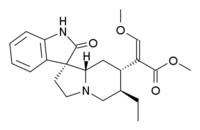Rhynchophylline
Rhynchophylline
 |
| Names |
| IUPAC name
Methyl (7β,16E,20α)-16-(methoxymethylene)-2-oxocorynoxan- 17-oate |
Other names
- Rhyncophylline
- Mitrinermin
- Mitrinermine
- Rhynchophyllin
- Rhynocophylline
- Methyl (E)-2-[(3R,6′R,7′S,8′aS)- 6'-ethyl-2-oxospiro[1H-indole-3,1'- 3,5,6,7,8,8a-hexahydro- 2H-indolizine]-7'-yl]-3-methoxyprop-2-enoate
|
| Identifiers |
| |
76-66-4  Y Y |
| 3D model (Jmol) |
Interactive image |
| ChEBI |
CHEBI:70069 |
| ChEMBL |
ChEMBL519266 |
| ChemSpider |
4444758 |
| ECHA InfoCard |
100.208.612 |
| KEGG |
C09236 |
| PubChem |
3033948 |
| UNII |
46BQ79VJ8D |
InChI=1S/C22H28N2O4/c1-4-14-12-24-10-9-22(17-7-5-6-8-18(17)23-21(22)26)19(24)11-15(14)16(13-27-2)20(25)28-3/h5-8,13-15,19H,4,9-12H2,1-3H3,(H,23,26)/b16-13+/t14-,15-,19-,22+/m0/s1 Key: DAXYUDFNWXHGBE-KAXDATADSA-N InChI=1/C22H28N2O4/c1-4-14-12-24-10-9-22(17-7-5-6-8-18(17)23-21(22)26)19(24)11-15(14)16(13-27-2)20(25)28-3/h5-8,13-15,19H,4,9-12H2,1-3H3,(H,23,26)/b16-13+/t14-,15-,19-,22+/m0/s1 Key: DAXYUDFNWXHGBE-KAXDATADBC
|
CC[C@H]1CN2CC[C@]3([C@@H]2C[C@@H]1/C(=C\OC)/C(=O)OC)C4=CC=CC=C4NC3=O
|
| Properties |
| |
C22H28N2O4 |
| Molar mass |
384.48 g·mol−1 |
Except where otherwise noted, data are given for materials in their standard state (at 25 °C [77 °F], 100 kPa). |
 N verify (what is N verify (what is  Y Y N ?) N ?) |
| Infobox references |
|
|
Rhynchophylline is an alkaloid found in certain Uncaria species (Rubiaceae), notably Uncaria rhynchophylla[1] and Uncaria tomentosa.[2] It also occurs in the leaves of Mitragyna speciosa (kratom),[3] a tree native to Thailand. Chemically, it is related to the alkaloid mitragynine.
Rhynchophylline is a non-competitive NMDA antagonist (IC50 = 43.2 μM) and a calcium channel blocker.[4][5]
Uncaria species have had a variety of uses in traditional herbal medicine, such as for lightheadedness, convulsions, numbness, and hypertension.[6] These uses have been associated with the presence of rhynchophylline and have encouraged its investigation as a drug candidate for several cardiovascular and central nervous system diseases; however, few clinically relevant studies have been conducted.[6]
See also
References
- ↑ Shi JS, Yu JX, Chen XP, Xu RX (2003). "Pharmacological Actions of Uncaria Alkaloids, Rhynchophylline and Isorhynchophylline" (pdf). Acta Pharmacologica Sinica. 24 (2): 97–101. PMID 12546715.
- ↑ Mohamed AF, Matsumoto K, Tabata K, Takayama H, Kitajima M, Watanabe H (2000). "Effects of Uncaria tomentosa Total Alkaloid and its Components on Experimental Amnesia in Mice: Elucidation Using the Passive Avoidance Test". Journal of Pharmacy and Pharmacology. 52 (12): 1553–1561. doi:10.1211/0022357001777612. PMID 11197086.
- ↑ "Mitragynine". Toxnet. March 2006.
- ↑ Kang TH, Murakami Y, Matsumoto K, Takayama H, Kitajima M, Aimi N, Watanabe H (2002). "Rhynchophylline and Isorhynchophylline Inhibit NMDA Receptors Expressed in Xenopus Oocytes". European Journal of Pharmacology. 455 (1): 27–34. doi:10.1016/S0014-2999(02)02581-5. PMID 12433591.
- ↑ Kang TH, Murakami Y, Takayama H, Kitajima M, Aimi N, Watanabe H, Matsumoto K (2004). "Protective Effect of Rhynchophylline and Isorhynchophylline on in vitro Ischemia-Induced Neuronal Damage in the Hippocampus: Putative Neurotransmitter Receptors Involved in their Action". Life Sciences. 76 (3): 331–343. doi:10.1016/j.lfs.2004.08.012. PMID 15531384.
- 1 2 Zhou J, Zhou S (2010). "Antihypertensive and neuroprotective activities of rhynchophylline: the role of rhynchophylline in neurotransmission and ion channel activity". Journal of Ethnopharmacology. 132 (1): 15–27. doi:10.1016/j.jep.2010.08.041. PMID 20736055.
|
|---|
|
Receptor
(ligands) | | AMPA | |
|---|
| | NMDA |
- Antagonists: Competitive antagonists: AP5 (APV)
- AP7
- CGP-37849
- CGP-39551
- CGP-39653
- CGP-40116
- CGS-19755
- CPP
- LY-233,053
- LY-235,959
- LY-274,614
- MDL-100,453
- Midafotel (d-CPPene)
- NPC-12,626
- NPC-17,742
- PBPD
- PEAQX
- Perzinfotel
- PPDA
- SDZ-220581
- Selfotel; Noncompetitive antagonists: ARR-15,896
- Caroverine
- Dexanabinol
- FPL-12495
- FR-115,427
- Hodgkinsine
- Magnesium
- MDL-27,266
- NPS-1506
- Psychotridine
- Zinc; Uncompetitive pore blockers: 2-MDP
- 3-HO-PCP
- 3-MeO-PCE
- 3-MeO-PCMo
- 3-MeO-PCP
- 4-MeO-PCP
- 8A-PDHQ
- 18-MC
- α-Endopsychosin
- Alaproclate
- Amantadine
- Aptiganel
- Arketamine
- ARL-12,495
- ARL-15,896-AR
- ARL-16,247
- Budipine
- Conaridine
- Delucemine
- Dexoxadrol
- Dextrallorphan
- Dieticyclidine
- Diphenidine
- Dizocilpine
- Ephenidine
- Esketamine
- Etoxadrol
- Eticyclidine
- Fluorolintane
- Gacyclidine
- Ibogaine
- Ibogamine
- Indantadol
- Ketamine
- Ketobemidone
- Lanicemine
- Loperamide
- Memantine
- Methadone (Levomethadone)
- Methorphan (Dextromethorphan
- Levomethorphan)
- Methoxetamine
- Methoxphenidine
- Milnacipran
- Morphanol (Dextrorphan
- Levorphanol)
- NEFA
- Neramexane
- Nitromemantine
- Nitrous oxide
- Noribogaine
- Norketamine
- Orphenadrine
- PCPr
- Pethidine (meperidine)
- Phencyclamine
- Phencyclidine
- Propoxyphene
- Remacemide
- Rhynchophylline
- Rimantadine
- Rolicyclidine
- Sabeluzole
- Tabernanthine
- Tenocyclidine
- Tiletamine
- Tramadol
- Xenon; Glycine site antagonists: 4-Cl-KYN (AV-101)
- 5,7-DCKA
- 7-CKA
- ACC
- ACEA-1011
- ACEA-1328
- AV-101
- Carisoprodol
- CGP-39653
- CNQX
- DNQX
- Felbamate
- Gavestinel
- GV-196,771
- Kynurenic acid
- Kynurenine
- L-689,560
- L-701,324
- Licostinel (ACEA-1021)
- LU-73,068
- MDL-105,519
- Meprobamate
- MRZ 2/576
- PNQX
- ZD-9379; NR2B subunit antagonists: Besonprodil
- CERC-301 (MK-0657)
- CO-101,244 (PD-174,494)
- Eliprodil
- Haloperidol
- Ifenprodil
- Isoxsuprine
- Nylidrin
- Ro8-4304
- Ro25-6981
- Traxoprodil; Polyamine site antagonists: Arcaine
- Co 101676
- Diaminopropane
- Diethylenetriamine
- Huperzine A
- Putrescine
- Ro 25-6981; Unclassified/unsorted antagonists: Bumetanide
- Chloroform
- Cyclopropane
- D-αAA
- Diethyl ether
- Enflurane
- Ethanol
- Flufenamic acid
- Flupirtine
- Furosemide
- Halothane
- Isoflurane
- Metaphit
- Methoxyflurane
- Niflumic acid
- Pentamidine isethionate
- Piretanide
- Toluene
- Transcrocetin (saffron)
- Trichloroethane
- Trichloroethanol
- Trichloroethylene
- Xylene
|
|---|
| | Kainate | |
|---|
| | mGlu1 | |
|---|
| | mGlu2 | |
|---|
| | mGlu3 | |
|---|
| | mGlu4 |
- Antagonists: CPPG
- MAP4
- MPPG
- MSOP
- MTPG
- UBP-1112
|
|---|
| | mGlu5 | |
|---|
| | mGlu6 |
- Antagonists: CPPG
- MAP4
- MPPG
- MSOP
- MTPG
- UBP-1112
|
|---|
| | mGlu7 |
- Antagonists: CPPG
- MAP4
- MMPIP
- MPPG
- MSOP
- MTPG
- UBP-1112
|
|---|
| | mGlu8 |
- Antagonists: CPPG
- MAP4
- MPPG
- MSOP
- MTPG
- UBP-1112
|
|---|
|
|---|
|
Transporter
(blockers) | |
|---|
|
Enzyme
(inhibitors) | |
|---|
|
| Others | |
|---|
|
See also: GABAergics • GHBergics • Glycinergics |
